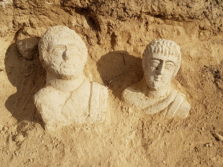It’s not every day that the average person finds 1,700-year-old sculptures, but that doesn’t mean it can’t happen during an everyday activity in Israel. A local resident recently discovered two “impressive” Roman busts near the city of Beit She’an in northern Israel while just taking a walk, according to a press release from the Israel Antiquities Authority (IAA).
The top of one of the two sculptures was poking out of the ground and seen by the woman, who along with her husband contacted the IAA Theft Prevention Unit. Inspectors sent to the site were able to find the antiquities, which are believed to be from the Late Roman period (3rd–4th centuries CE).
Nir Distelfeld, IAA Theft Prevention Unit inspector, said in the press release, “It seems that the busts were exposed following the recent heavy rainfall in the area. These are very important finds, which tell us a great deal about the inhabitants of the Beth She’an area in antiquity. We thank the Beit She’an resident for her alertness and good citizenship and she will receive a certificate of appreciation.”
The details on the busts show clothing and hairstyles—at least one appears to show a beard—according to Dr. Eitan Klein, deputy head of the IAA Theft Prevention Unit. Klein was quoted by the IAA press release as noting the facial features of the busts are unique. “Busts like these were usually placed near or in a burial cave, and they may have represented the image of the deceased along general lines,” said Klein. “Similar busts have been found in the past in the Beit She’an area and in northern Jordan. But not one resembles another, and that’s the importance of these finds.”
The sculptures not only show what individuals may have looked like, but also say something about the style of art in that time period.
“These busts are in the Oriental style, which shows that at the end of the Roman period the use of Classical art had subsided, and local trends came into vogue,” said Klein.
It seems only appropriate then that a local resident of today found the sculptures, but that doesn’t mean that the archeological art will only be enjoyed by locals. “These finds belong to everyone in the country, and now we can all enjoy them and
understand their historical context,” Distelfeld was quoted as saying. “I don’t want to think about what would have happened if these finds had gotten into the wrong hands. It’s important to note that heavy winter rains can bring other finds to the surface and we call on people to report them to us.”
(By Joshua Spurlock, www.themideastupdate.com, December 30, 2018)

